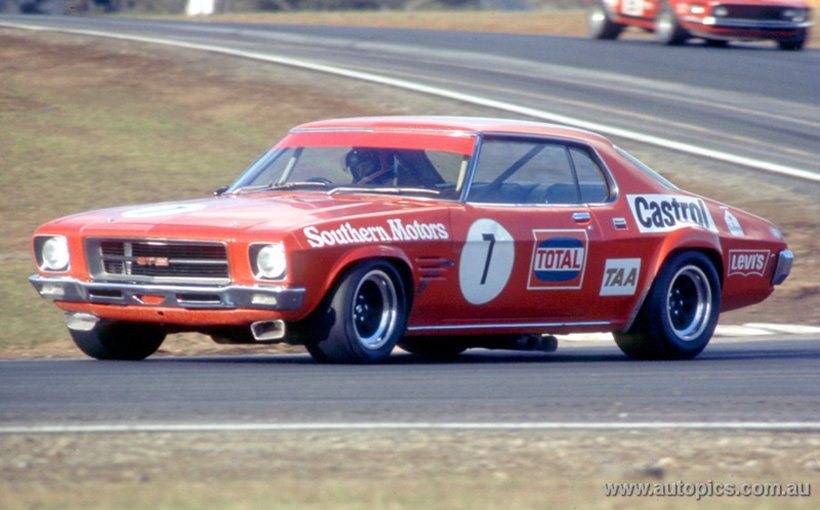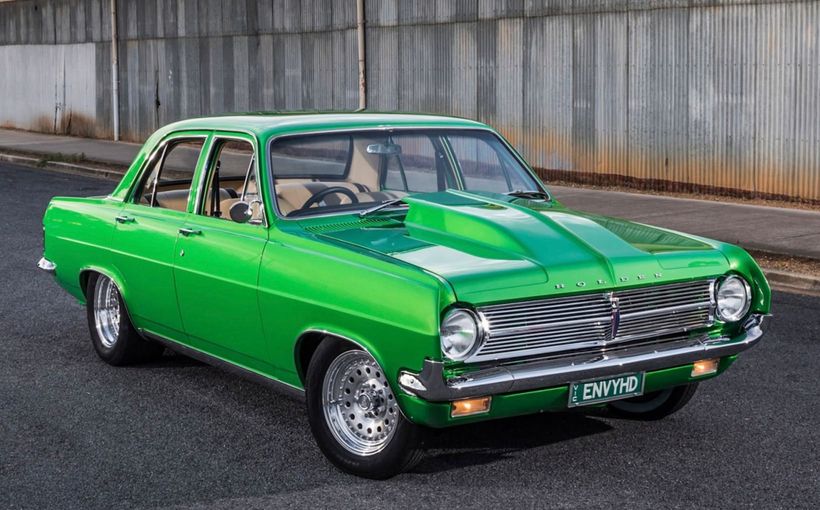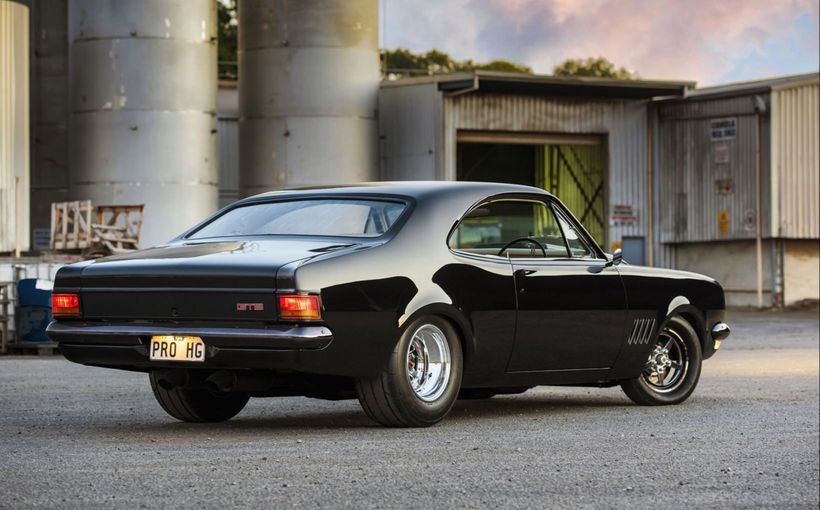Holden HQ Monaro: Bob Jane’s magnificent GTS 350

Tyre retailing giant Bob Jane owned and raced some of the fastest and most exciting sports cars and sedans in Australia. Arguably the most successful and fondly remembered was the HQ Monaro GTS 350 which the Bob Jane Racing Team campaigned with great success throughout the 1970s.
Although it was conceived as a state-of-the-art Improved Production car, the demise of that class at the end of 1972 saw it reassigned to a new career in Sports Sedan racing where Jane and his mighty Monaro continued to be one of the toughest combinations to beat for six consecutive seasons.
The fact that this broad-shouldered coupe clung to its traditional front engine/live rear axle muscle car roots highlights how fundamentally ‘right’ it was from the moment it hit the track.
As mid-engined rivals became increasingly radical and sophisticated, the Jane team’s never-ending process of engine and chassis refinements kept it at the top of its game until it was sold at the end of the 1978 season.

A star is born
Since its inception in 1960, the Australian Touring Car Championship (ATCC) was dominated by imported makes and models starting with Jaguars before Ford’s mighty Mustang became the car to beat in the latter half of that decade.
Norm Beechey finally broke the US pony car’s stranglehold on the title in 1970, when his HT Monaro GTS 350 became the first Holden - and first Australian car - to win it.
However, Norm’s historic breakthrough was short-lived as Bob Jane’s new Chevrolet Camaro ZL-1, powered by a huge 7.0 litre (427 cid) big block V8, stormed to victory in 1971.
Jane’s Camaro, though, with its exotic all aluminium Can-Am engine was based on a very rare US factory specification designed primarily for NHRA Super Stock drag racing. Less than 100 had been built, so it did not represent the sort of ‘mainstream’ model that the local touring car class was designed to cater for.
For the 1972 season, governing body CAMS proposed some key rule changes to rein in the performance advantage of imported supercars like Jane’s Camaro and Allan Moffat’s Trans-Am Mustang to make locally-made performance models more appealing as potential race cars.

A 6.0 litre engine capacity limit, mandatory use of rear drum brakes plus other restrictions were rubber-stamped for 1972 which had the desired effect of bringing the exotic imports in line with the best local offerings from Ford and Holden.
These proposed changes could not have been better timed, given the release of Holden’s new HQ model range in mid-1971. This included the high performance Monaro, with the premium choice being the GTS 350 equipped with the imported 5.7 litre (350 cid) small block Chevrolet V8.
The new GTS 350, with its sleek two-door coupe body, was the obvious replacement for Jane’s Camaro in its less powerful 5.7 litre/rear drum-braked specification for compelling reasons.
At the time Jane was one of the largest Holden dealers in Australia through his Southern Motors dealership, so from a marketing perspective it made sense to race what he sold as the general public could relate better to a Holden than a rare US import.
The Monaro would also share the same Chevrolet-based running gear so the transition to the local car would be painless. And the easy availability of local Holden parts and panels would make servicing and repairs easier and less expensive.

Building the beast
The decision to build a new HQ Monaro race car was made as soon as Holden released its new HQ model range in July 1971.
Ace race mechanics John Sheppard and Pat Purcell were assigned this exacting task, as Sheppard had recently replaced John Sawyer as manager of Jane’s Melbourne-based racing team at 740 Sydney Road, Brunswick.
In early 1971 Sheppard had built a wild 4.4 litre Repco V8-powered Torana GTR XU-1 sports sedan for Jane while he was service manager at Southern Motors, so he was the right man for the job when it came to building what would become one of Australia’s fastest and most enduring Monaro race cars.
Initial claims that the HQ’s four-door sedan body was lighter than the two-door were soon dismissed when Sheppard put one of each on a weighbridge. The coupe body was not only lighter but he also reasoned that with two less doors it would also be more structurally rigid. He also thought the coupe shape would make a better looking race car.
When the build commenced in mid-1971, the plan was that Jane would chase back-to-back ATCC titles in his Camaro in 1972, with the new HQ Monaro to be phased in during the season with Jane’s hired gun John Harvey at the wheel.

Under the Improved Production rules, cars had to retain their original interior trim right down to the floor carpets. Whilst this requirement retained extra weight in the cars, it also provided plenty of opportunities to bend the rules by finding weight savings in other areas well hidden from inspectors’ eyes.
The HQ body shell was a very sturdy structure to start with, so the car was stripped back to a bare shell and hole-saws in a variety of diameters were used to drill out hidden sections of the structural sheetmetal throughout the body to reduce weight.
This drilling process extended to many hidden items, from heavy steel bumper brackets right down to internal door locks and window winder mechanisms. Lightweight aluminium nuts and bolts replaced original steel ones where possible and with Jane’s strong GM connections, heavy items like bumper bars were restamped from wafer-thin sheet metal.
A stout fully welded roll cage made from thin-wall chrome moly steel tubing was installed to provide crash safety for drivers and boost chassis stiffness.
The car’s standard suspension had to be retained, but it was lowered and stiffened with uprated coil springs, anti-sway bars and Koni adjustable shock absorbers. Solid steel bushes replaced the standard rubber items for sharper handling response. A Watts linkage was also fitted to the rear axle for positive lateral location and roll centre adjustment.

In true Trans-Am tradition, there was also a subtle relocation of the cast iron 350 V8, which was moved further back and lower down than its standard positioning. Being the heaviest component in the car, this had a noticeable effect on handling response due to a lower centre of gravity and reduced polar moment of inertia.
Powerful braking came from big 12-inch (305mm) diameter Lockheed ventilated disc rotors and four-spot calipers at the front with chunky finned drums at the rear, mounted inside featherweight 15 x 10-inch magnesium Minilite wheels from the UK.
The 350 cid Chevrolet V8 built for this car was a work of art, with a unique Lucas-based slide throttle fuel injection system that was at the cutting edge of Improved Production technology and the equal of anything in the world at the time.
The HQ’s stout 350 small block featured the best imported high performance internals including a three-stage dry sump, rugged four-bolt main bearing block, forged steel crankshaft, lightweight rods, forged 11:1 pistons, roller camshaft, fully ported and polished cylinder heads and huge exhaust extractors that dumped into two open pipes that poked out under the passenger door.
This was all tried and tested muscle car hardware and, if Sheppard followed that tradition, it would have been topped with a lightweight inlet manifold and either a quartet of dual-choke Webers or a big Holley Dominator or two.

However, what Sheppard wanted to achieve from the start was what he described as “a proper racing engine” to avoid the shortcomings typically associated with carburettor induction systems.
The ultimate set-up was mechanical fuel injection with slide throttles; one injection trumpet per cylinder and short, straight inlet paths all the same length, size and shape. However, as Sheppard’s manifold design blocked the standard distributor hole at the rear of block, the distributor was relocated to the front of the engine.
There it was mounted in a purpose-built V-shaped housing it shared with the Lucas timed fuel injection’s metering unit, with both sharing drive from a common shaft and pulley driven by a toothed belt from the crankshaft. It was such a neat and clever way to solve this issue.
Sheppard designed an aluminium inlet manifold in-house that consisted of four identical castings with two ram tubes each. These were interchangeable, so that if one was damaged ‘in the field’ it could be easily replaced.
These manifolds were cast and machined by the Commonwealth Aircraft Corporation (CAC) and were unique to the Jane Monaro, matched to slide-throttle mechanisms that featured huge 2.0-inch (50mm) square ports.
This state-of-the-art fuel injection system, combined with the many other engine modifications, produced 550 bhp (410 kW) at 7200 rpm and 550 ft/lbs (742 Nm) of torque at around 4500 rpm. In 1972, these were staggering figures for a production-based 5.7 litre V8.

Sheppard soon discovered that his design would need refining, as Jane and Harvey both compared its power delivery to that of a light switch; when they leaned on the throttle all hell broke loose.
The problem was traced to the slide throttle’s square-shaped ports. These were later changed to round ports, to allow the more gradual opening needed for a more progressive throttle response.
A lightened flywheel and Borg & Beck multi-plate clutch was matched with a GM Muncie M22 ‘Rockcrusher’ four-speed gearbox equipped with a Holinger close-ratio gear set. The coil-sprung live rear axle relied on a rugged GM 12-bolt centre equipped with a Weisman LSD to get all that V8 grunt to ground through huge 15 x 10-inch tyres.
Jane’s new Monaro made its competition debut in John Harvey’s hands at the Surfers Paradise round of the 1972 ATCC, pretty much a year after construction had begun.
Bristling with the latest technology and a peerless standard of workmanship, Sheppard’s and Purcell’s hard work paid off when the new Monaro raced to an impressive second place behind Jane’s ‘350’ Camaro.
More proof of the Monaro’s potential came two weeks later at Sydney’s Oran Park for the 1972 ATCC final, where in only its second outing Harvey qualified fourth fastest and only 0.2 sec slower than Jane’s Camaro.
Harvey also engaged in a thrilling battle for second place with Allan Moffat’s Trans-Am Mustang, which lasted for more than half the race before Harvey was forced to surrender due to a persistent brake problem.
With another ATCC crown in the bag, Jane took over the Monaro as planned for the remainder of the 1972 season and showed they would be a potent combination, with a big win and several top placings in major meetings held at Calder and Sydney’s Warwick Farm.

1973-1978: The Sports Sedan era
Unfortunately, Jane’s HQ Monaro was destined to enjoy a short career as an Improved Production car, as major category changes introduced by CAMS in the wake of the 1972 Supercar Scare also changed the Monaro’s destiny.
For 1973, the showroom stock Series Production rules which applied to the annual Bathurst 500 race were axed along with the ATCC’s Improved Production class.
In their place came a new set of rules for touring cars called ‘Production Touring – Group C’ which in effect combined Series Production and Improved Production in the one category. These cars would compete for both the Bathurst 500/1000 and ATCC titles.
The more highly modified Improved Production cars were left with nowhere to go but the Sports Sedan class, which allowed for almost limitless modifications to engines, chassis and aerodynamics.
This hybrid category would foster some increasingly radical cars in the years to come, including mid-engined designs and lots of open wheeler racing car technology like Bryan Thomson’s Chevrolet V8-powered Volkswagen Type III Fastback and John McCormack’s Repco-Holden V8-powered Valiant Charger.

Even so, from 1973 to 1975 Jane’s mighty HQ Monaro remained little changed from its 1972 Improved Production specs, as its comparatively simple muscle car credentials of a powerful V8 in a light and rigid unitary body-chassis proved to be enduringly competitive.
The most noticeable visual change came in 1974 when stylish white stripes appeared along the flanks of the Monaro, which displayed Jane’s various sponsors and provided a classy contrast with the team’s Sebring Orange base colour. This paint scheme was adopted by all the Bob Jane Racing Team cars from then on.
In 1974 the Monaro sprouted front and rear spoilers as Jane concentrated most of his racing efforts on winning the inaugural $100,000 Marlboro Sports Sedan Series at Melbourne’s Calder Park.
Jane proved almost unbeatable on his home turf, winning four of the five rounds with his victories shared equally between the Monaro and Repco V8-powered Torana.

For 1975 the Monaro went on a crash diet after Jane was soundly beaten by Pete Geoghegan’s new John Sheppard-built 350 V8-powered ‘Craven Mild’ HJ Monaro when it debuted at Calder early in the year.
Jane’s chief mechanic Pat Purcell replaced several of the Monaro’s steel panels with lightweight fiberglass items, removed anything in the car that wasn’t required and lightened what had to remain. This drastic weight loss program trimmed about 130 kgs. Jane proved the effectiveness of such a simple change when he immediately smashed the Calder lap record by almost a second.
It was this process of constant chassis, engine and aerodynamic refinements that kept the Monaro’s competitive edge razor sharp, with Jane again toppling the best in the business to win the 1975 Marlboro series.
For its 1976 series’ defence, the Monaro was noticeably changed with a new love-it-or-loathe-it yellow colour scheme, a much larger rear spoiler for extra downforce and for the first time a rear-facing bonnet scoop that allowed the engine to draw its induction air from the low pressure zone at the base of the windscreen.

The new scoop also provided extra clearance needed for the taller fuel injection trumpets on a new 350 cid Chevrolet V8 imported from US race engine specialists Falconer & Dunn, which after Purcell’s local fine tuning on the dyno was producing more than 600 bhp.
In this ferocious configuration, Jane set the first 100 mph (160 km/h) lap average for a sedan at Melbourne’s Sandown Park and won the first round of the big dollar Marlboro series at Calder.
Jane missed out on a hat-trick of series wins, though, as rivals raised the competitive bar to new heights. Cars like Allan Moffat’s 350 V8-powered DeKon Chevrolet Monza, Frank Gardner’s radical mid-engined V8 Chevrolet Corvair and HDT’s new LH Torana with a mid-mounted Repco-Holden F5000 V8 tackled both the Calder series and the newly announced Australian Sports Sedan Championship (ASSC).

The venerable Monaro was updated again for the 1977 season, its fifth consecutive year at the top level of Sports Sedan racing. With a fresh take on its traditional orange colour scheme and with more elaborate changes to the bodywork, the biggest change under the skin was an inevitable relocation of the engine which was moved back about 600mm to improve the car’s weight distribution.
Jane proved to be the only real threat to Frank Gardner’s Corvair in the 1977 ASSC, but a loss of points earned at Sandown after Jane clashed with another competitor cost him any chance of winning the title.
In 1978, the Jane-Monaro combination which had enjoyed so much success had reached its inevitable conclusion. Jane hardly drove the car that year and with news that Pat Purcell was building a radical Chevrolet Monza to replace it, the car was sold at the end of the season.
It did, however, prove its enduring speed at Calder Park that year when Holden hero Peter Brock did a one-off guest drive in the car for two 10-lap sprint races.

On this occasion the Monaro’s body was coated in a special skin of latex, which allowed it to run Brock’s familiar red and white Marlboro HDT race livery that was simply peeled off at the end of the meeting. Brock engaged in two thrilling duels with Jim Richards in his NZ-built XC Falcon hardtop, winning both heats as they scorched around Calder Park at sub-lap record speeds.
Brock’s dazzling guest drive proved there was plenty of life left in the old girl. Sydney’s Phil Ward became its second owner, during which time it continued to be a front runner recording several podium finishes in the ASCC. It was then sold to Shepparton-based Tino Leo, who raced it for several seasons with mixed results before parking it.
The famous Monaro sat gathering dust for many years before being purchased by sports sedan racer Des Wall, who completed a ground-up rebuild of the car with a modern interpretation of its original Improved Production specs, as he had a return to competition in mind.
Wall planned to compete in the Historic Group Nc (1965-1972) touring car category with the famous car, before his untimely death from illness in 2012.
Protect your Monaro. Call Shannons Insurance on 13 46 46 to get a quote today.









